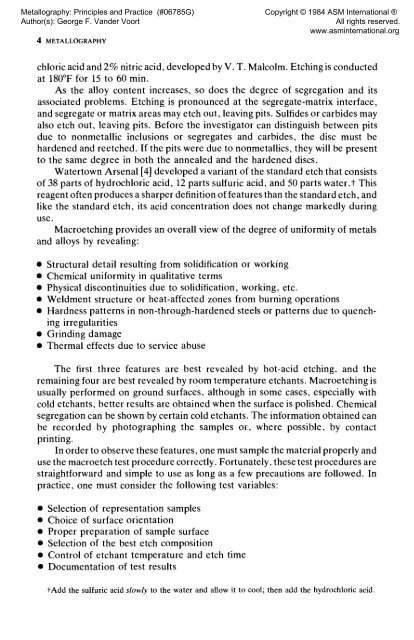Metallography: Principles and Practices - ASM International
Metallography: Principles and Practices - ASM International
Metallography: Principles and Practices - ASM International
You also want an ePaper? Increase the reach of your titles
YUMPU automatically turns print PDFs into web optimized ePapers that Google loves.
<strong>Metallography</strong>: <strong>Principles</strong> <strong>and</strong> Practice (#06785G)<br />
Author(s): George F. V<strong>and</strong>er Voort<br />
4 METALLOGRAPHY<br />
chloric acid <strong>and</strong> 2% nitric acid, developed by V. T. Malcolm. Etching is conducted<br />
at 180°F for 15 to 60 min.<br />
As the alloy content increases, so does the degree of segregation <strong>and</strong> its<br />
associated problems. Etching is pronounced at the segregate-matrix interface,<br />
<strong>and</strong> segregate or matrix areas may etch out, leaving pits. Sulfides or carbides may<br />
also etch out, leaving pits. Before the investigator can distinguish between pits<br />
due to nonmetallic inclusions or segregates <strong>and</strong> carbides, the disc must be<br />
hardened <strong>and</strong> reetched. If the pits were due to nonmetallics, they will be present<br />
to the same degree in both the annealed <strong>and</strong> the hardened discs.<br />
Watertown Arsenal [4] developed a variant of the st<strong>and</strong>ard etch that consists<br />
of 38 parts of hydrochloric acid, 12 parts sulfuric acid, <strong>and</strong> 50 parts water.t This<br />
reagent often produces a sharper definition of features than the st<strong>and</strong>ard etch, <strong>and</strong><br />
like the st<strong>and</strong>ard etch, its acid concentration does not change markedly during<br />
use.<br />
Macroetching provides an overall view of the degree of uniformity of metals<br />
<strong>and</strong> alloys by revealing:<br />
• Structural detail resulting from solidification or working<br />
• Chemical uniformity in qualitative terms<br />
• Physical discontinuities due to solidification, working, etc.<br />
• Weldment structure or heat-affected zones from burning operations<br />
• Hardness patterns in non-through-hardened steels or patterns due to quenching<br />
irregularities<br />
• Grinding damage<br />
• Thermal effects due to service abuse<br />
The first three features are best revealed by hot-acid etching, <strong>and</strong> the<br />
remaining four are best revealed by room temperature etchants. Macroetching is<br />
usually performed on ground surfaces, although in some cases, especially with<br />
cold etchants, better results are obtained when the surface is polished. Chemical<br />
segregation can be shown by certain cold etchants. The information obtained can<br />
be recorded by photographing the samples or, where possible, by contact<br />
printing.<br />
In order to observe these features, one must sample the material properly <strong>and</strong><br />
use the macroetch test procedure correctly. Fortunately, these test procedures are<br />
straightforward <strong>and</strong> simple to use as long as a few precautions are followed. In<br />
practice, one must consider the following test variables:<br />
• Selection of representation samples<br />
• Choice of surface orientation<br />
• Proper preparation of sample surface<br />
• Selection of the best etch composition<br />
• Control of etchant temperature <strong>and</strong> etch time<br />
• Documentation of test results<br />
Copyright © 1984 <strong>ASM</strong> <strong>International</strong> ®<br />
All rights reserved.<br />
www.asminternational.org<br />
tAdd the sulfuric acid slowly to the water <strong>and</strong> allow it to cool; then add the hydrochloric acid.
















